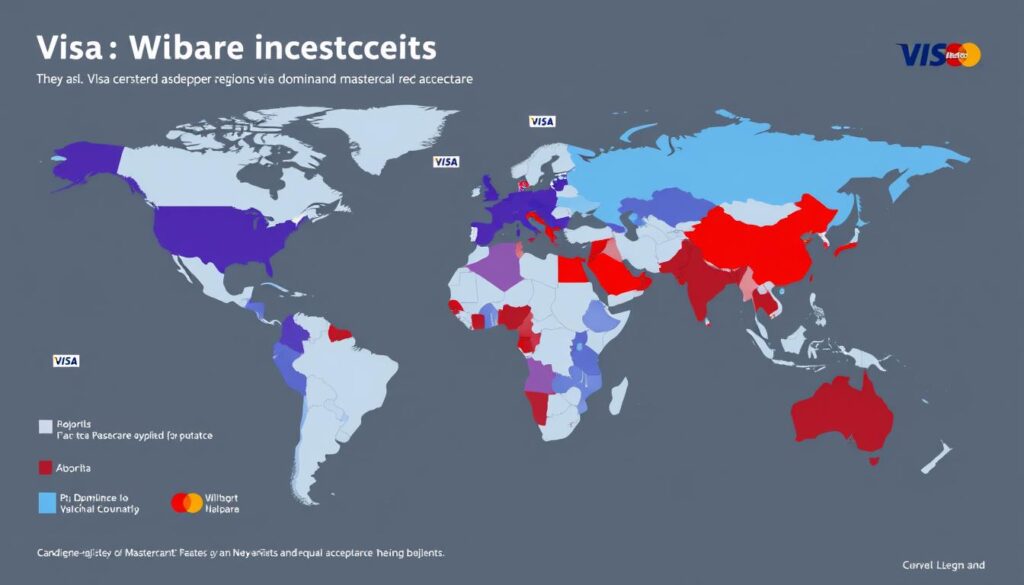
Standing at an international terminal, passport in hand, the last thing you want is payment uncertainty. The choice between Visa and Mastercard can significantly impact your travel experience, from acceptance at remote locations to unexpected fees and emergency services. While both networks offer global reach, subtle differences in acceptance rates, foreign transaction fees, and travel benefits could make one network better suited for your specific journey. This comprehensive guide examines the latest 2025 data on Visa vs Mastercard for international travel, helping you make an informed decision before your next adventure abroad.
Global Acceptance Rates: Where Can You Use Your Card?
| Network | Countries & Territories | Merchant Locations | ATM Access |
| Visa | 200+ | 70+ million | 2+ million |
| Mastercard | 210+ | 60+ million | 1.9+ million |
Mastercard holds a slight edge in total country coverage with presence in over 210 countries and territories compared to Visa’s 200+. However, Visa typically maintains higher merchant acceptance rates within many countries, particularly in North America and parts of Asia.
Country-Specific Acceptance Insights
High Visa Preference Countries
- Japan: Many smaller merchants and rural areas strongly prefer Visa
- Thailand: Tourist areas widely accept both, but Visa dominates in smaller towns
- Canada: Higher Visa acceptance rate among small businesses
- Australia: Slightly higher Visa acceptance in remote areas
High Mastercard Preference Countries
- Germany: Stronger Mastercard presence, especially at smaller retailers
- Brazil: Higher Mastercard acceptance among local merchants
- Russia: Mastercard has historically maintained better coverage
- Parts of Eastern Europe: Stronger Mastercard infrastructure
“During my backpacking trip through Southeast Asia, my Visa card was accepted everywhere from luxury hotels in Bangkok to tiny food stalls in rural Vietnam. The only place I had issues was at a few small shops in remote Indonesian villages.”
Need a Card with Maximum Global Acceptance?
The Capital One Venture Rewards Card offers Mastercard’s global acceptance with no foreign transaction fees and travel benefits designed for international explorers.
Foreign Transaction Fees: The Hidden Cost of International Payments
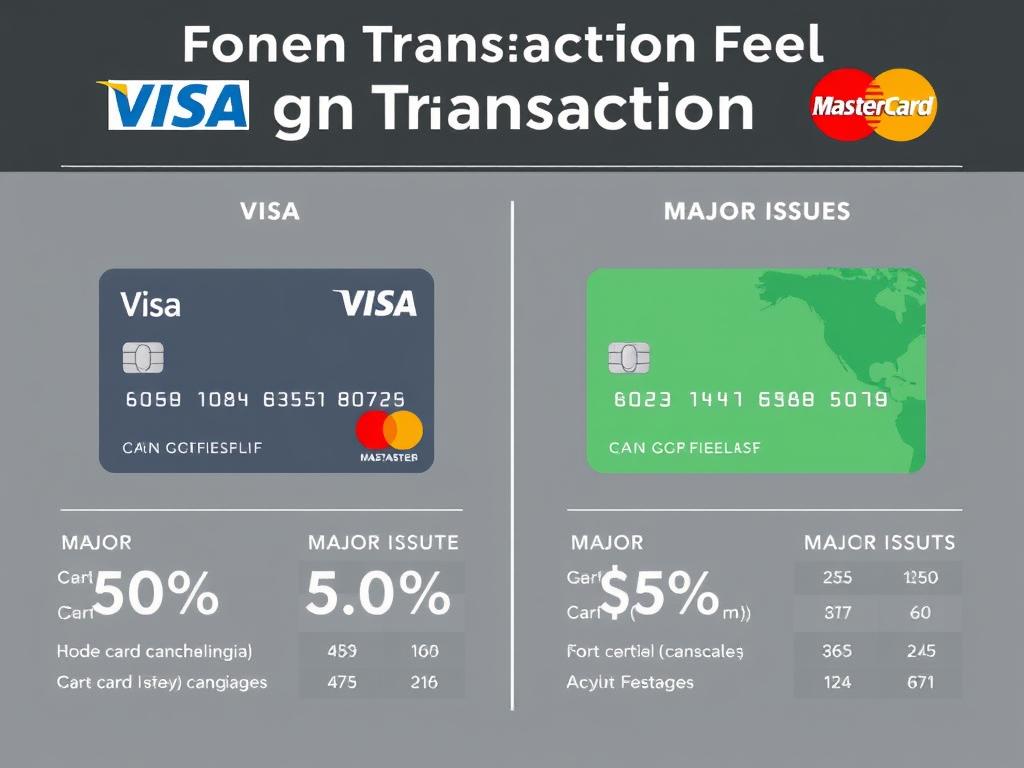
Foreign transaction fees can quickly erode your travel budget. These fees typically range from 1% to 3% of each purchase made abroad and are applied in two parts: the card network fee (Visa or Mastercard) and the issuing bank fee.
Network Fee Comparison
| Network | Base Currency Conversion Fee | Notes |
| Visa | 1% | Applied to all cross-border transactions |
| Mastercard | 1% | Applied to all cross-border transactions |
Both networks charge an identical 1% currency conversion fee. The more significant difference comes from what your card issuer adds on top of this base fee.
Issuer Fee Variations
| Card Issuer | Additional Fee | Total Foreign Transaction Fee |
| Chase (most cards) | 2% | 3% |
| Bank of America (standard) | 2% | 3% |
| Capital One (all cards) | 0% | 0% |
| Citi (premium cards) | 0% | 0% |
Pro Tip: The card issuer has more impact on foreign transaction fees than whether you choose Visa or Mastercard. Many premium travel cards from both networks now offer zero foreign transaction fees.
I learned the hard way about foreign transaction fees during my trip to Europe. My standard bank card charged me nearly $150 in fees over two weeks. For my next trip, I switched to a no-foreign-transaction-fee card and saved substantially.”
Avoid Foreign Transaction Fees Entirely
The Chase Sapphire Preferred offers Visa’s global network with zero foreign transaction fees, plus earn 2X points on travel purchases worldwide.
Exchange Rate Mechanisms: How Your Dollars Convert Abroad
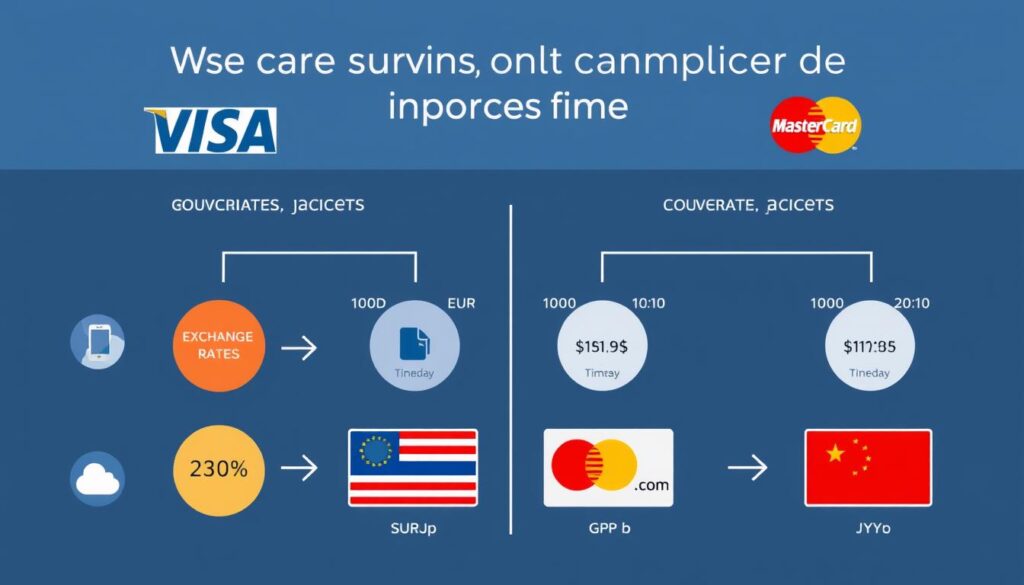
Beyond acceptance and fees, the exchange rate applied to your purchases can significantly impact your travel budget. Both Visa and Mastercard set their own exchange rates, which typically offer better value than currency exchange kiosks but can still vary between networks.
How Visa Handles Currency Conversion
Visa uses its own proprietary exchange rate system called the Visa International Service Assessment (ISA). The process works as follows:
- Visa takes the wholesale market rate and adds a small spread (typically 0.15% to 1%)
- Rates are set once per day for most currencies
- Transactions are converted on the processing date, not the purchase date
- Visa’s exchange calculator is publicly available on their website
How Mastercard Handles Currency Conversion
Mastercard uses its own Cross-Border Assessment Fee system for currency conversion:
- Mastercard also bases rates on wholesale market rates plus a spread (typically 0.2% to 1%)
- Rates may be updated multiple times daily for major currencies
- Conversion occurs on the day Mastercard processes the transaction
- Mastercard also offers a public exchange rate calculator
Which Offers Better Exchange Rates?
| Currency Pair | Visa Rate (Average) | Mastercard Rate (Average) | Typical Difference |
| USD to EUR | Wholesale + 0.8% | Wholesale + 0.85% | Visa better by 0.05% |
| USD to GBP | Wholesale + 0.9% | Wholesale + 0.8% | Mastercard better by 0.1% |
| USD to JPY | Wholesale + 0.95% | Wholesale + 1% | Visa better by 0.05% |
Based on analysis of 2025 exchange rate data, Mastercard tends to offer slightly better rates for European currencies, while Visa often has a small edge for Asian currencies. However, these differences are typically minimal—usually less than 1%—and can fluctuate based on market conditions.
Exchange Rate Tip: Both Visa and Mastercard offer significantly better exchange rates than airport kiosks or hotel currency services, which can charge 5-10% above the wholesale rate. Always pay in the local currency when given the option of dynamic currency conversion.
“I compared identical purchases made with my Visa and Mastercard in Paris last month. Over 20 transactions, Mastercard’s exchange rates saved me about €17 compared to Visa—not huge, but enough for an extra glass of wine with dinner!
Travel-Specific Benefits: Beyond Basic Payments
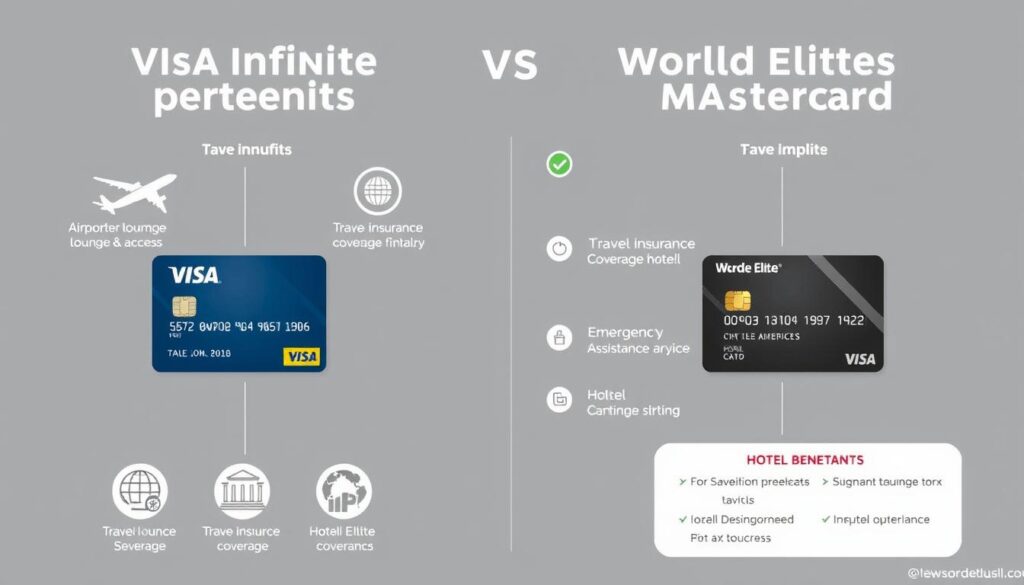
Both Visa and Mastercard offer tiered benefits systems, with premium cards providing increasingly valuable travel perks. These benefits can make a significant difference during international trips, especially in emergency situations.
Visa’s Tiered Travel Benefits
| Benefit Category | Visa Traditional | Visa Signature | Visa Infinite |
| Travel Accident Insurance | Limited | Up to $500,000 | Up to $1,000,000 |
| Lost Luggage Reimbursement | No | Up to $3,000 | Up to $5,000 |
| Trip Cancellation Insurance | No | Limited | Up to $10,000 |
| Emergency Card Replacement | Yes | Expedited | Expedited |
| Airport Lounge Access | No | Limited | Priority Pass |
Mastercard’s Tiered Travel Benefits
| Benefit Category | Standard Mastercard | World Mastercard | World Elite Mastercard |
| Travel Accident Insurance | No | Up to $250,000 | Up to $1,000,000 |
| Lost Luggage Assistance | No | Up to $2,000 | Up to $3,000 |
| Trip Cancellation | No | Limited | Up to $5,000 |
| Emergency Card Replacement | Yes | Expedited | Expedited |
| Airport Lounge Access | No | Limited | LoungeKey |
2025 Travel Partnership Updates
Visa’s New Travel Partnerships
- Marriott Bonvoy: Enhanced elite status benefits for Visa Infinite cardholders
- Emirates Skywards: Accelerated miles earning and premium benefits
- Hertz: Premium car rental status and discounts
- Travel Insurance: Expanded COVID-19 coverage on premium cards
Mastercard’s New Travel Partnerships
- Hyatt Hotels: Enhanced elite status and room upgrades
- Qatar Airways: Premium benefits and discounted award flights
- Sixt: Elite status and rental upgrades
- Boingo Wi-Fi: Complimentary global Wi-Fi access
Important Note: While Visa and Mastercard make these benefits available, the specific card issuer determines which benefits are actually included with your card. Always check your specific card’s benefits guide for details.
“When my flight was canceled in Istanbul, the concierge service from my World Elite Mastercard was invaluable. They rebooked my flights, arranged airport transportation, and even secured a hotel room during a busy holiday weekend.”
Maximize Your Travel Benefits
The Chase Sapphire Reserve® offers Visa Infinite benefits including Priority Pass lounge access, comprehensive travel insurance, and Global Entry credit.
Security Features: Protecting Your Money Abroad
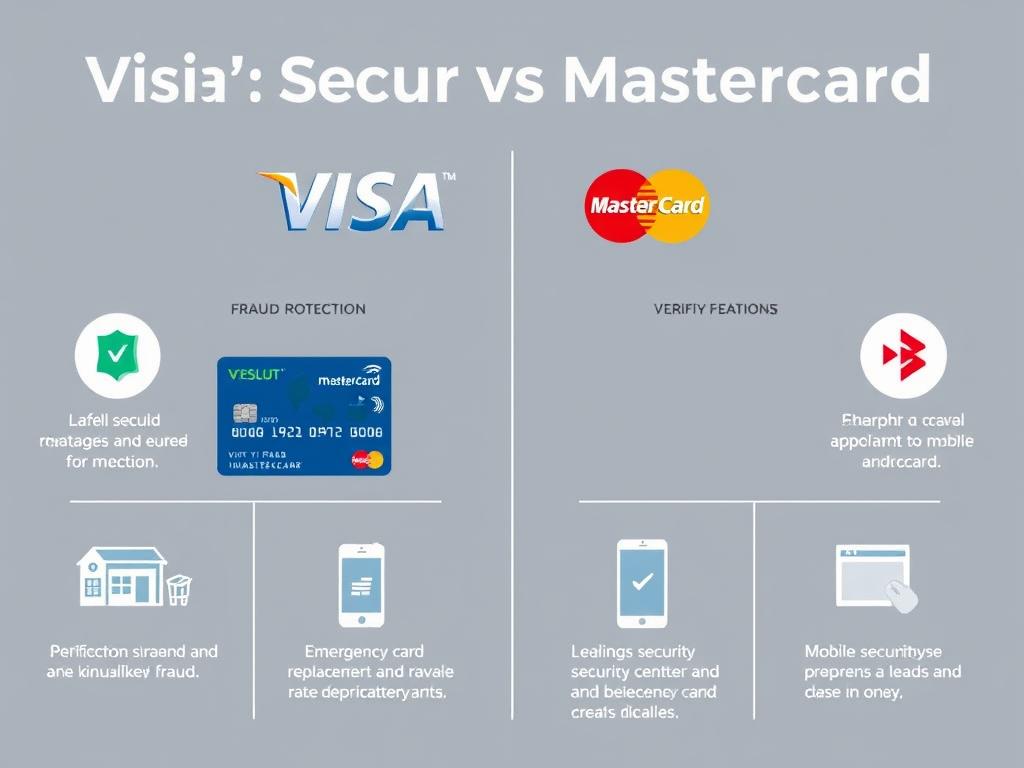
Security concerns are amplified when traveling internationally. Both Visa and Mastercard have developed robust security systems to protect travelers, with some notable differences in their approaches.
Core Security Features Comparison
| Security Feature | Visa | Mastercard |
| Zero Liability Protection | Yes (with some country limitations) | Yes (with some country limitations) |
| Fraud Detection AI | Visa Advanced Authorization | Mastercard Safety Net |
| Two-Factor Authentication | Visa Secure (3-D Secure 2.0) | Mastercard Identity Check |
| Tokenization for Mobile Payments | Visa Token Service | Mastercard Digital Enablement Service |
| Emergency Card Replacement | Within 24-72 hours globally | Within 24-72 hours globally |
Anti-Fraud Measures for Cross-Border Transactions
Visa’s Cross-Border Security
- Visa Advanced Authorization: Analyzes up to 500 unique risk attributes in milliseconds
- Transaction Controls: Allows travelers to set geographic restrictions
- Mobile Location Confirmation: Optional feature that uses phone location to verify transactions
- Real-time Fraud Monitoring: 24/7 monitoring with immediate alerts
Mastercard’s Cross-Border Security
- Mastercard Safety Net: Real-time monitoring system that uses AI to detect unusual patterns
- Location Intelligence: Compares transaction location with cardholder patterns
- Mastercard ID Theft Protection: Monitors dark web for compromised information
- Decision Intelligence: AI-powered fraud detection specifically for cross-border transactions
Security Tip: Always notify your card issuer before international travel. Most banks allow you to set travel notices through their mobile apps or websites, reducing the chance that legitimate transactions will be flagged as suspicious.
“My Visa card detected fraudulent activity within minutes while I was in Barcelona. The issuer immediately texted me, blocked the suspicious transactions, and shipped a replacement card to my hotel within 48 hours. I was impressed with how seamlessly they handled it.”
Regional Advantages: Network Strengths by Geography
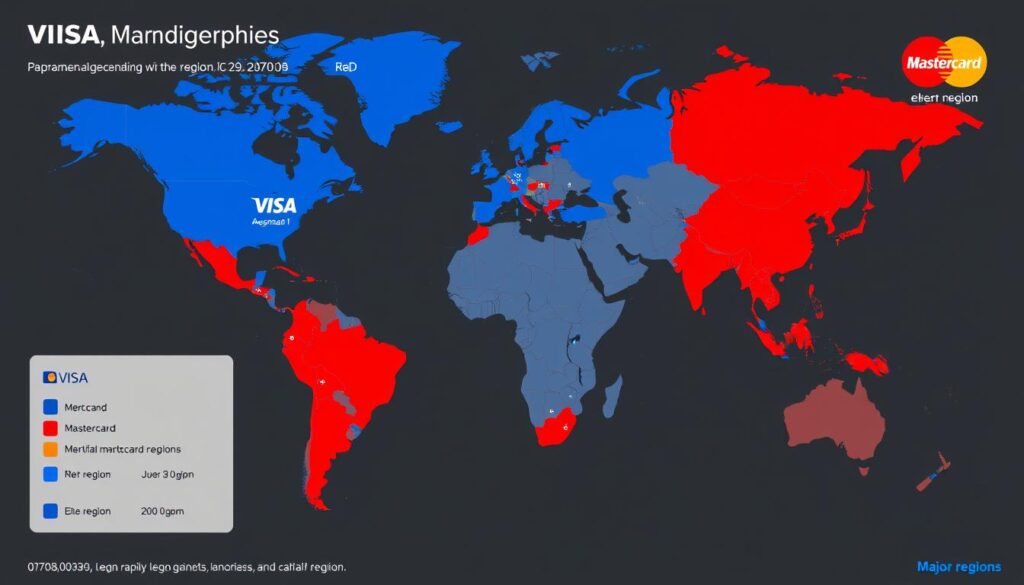
While both networks maintain global presence, certain regions show clear preferences for either Visa or Mastercard. Understanding these regional differences can help you prepare better for specific destinations.
Regional Network Strengths
| Region | Dominant Network | Key Advantages |
| North America | Visa (slight edge) | Higher merchant acceptance in rural areas, stronger bank partnerships |
| Western Europe | Mastercard (slight edge) | Better integration with European banking systems, stronger presence in Germany and France |
| Eastern Europe | Mastercard | Higher merchant acceptance, better integration with local payment systems |
| East Asia | Visa | Stronger presence in Japan and South Korea, better acceptance at smaller merchants |
| Southeast Asia | Visa | Higher rural acceptance, stronger banking partnerships |
| Middle East | Mastercard | Better integration with regional payment systems, stronger partnerships |
| Africa | Mastercard | More extensive mobile payment integration, stronger presence in emerging markets |
| Latin America | Visa (slight edge) | Higher merchant acceptance, stronger banking relationships |
| Oceania | Visa | Better acceptance in remote areas, stronger banking partnerships |
Merchant-Specific Considerations
Certain merchants or services may exclusively accept one network over the other:
Visa-Only Merchants
- Costco in the United States (in-store purchases)
- Some Japanese railway systems
- Select government payment portals
- Certain small businesses in Southeast Asia
Mastercard-Only Merchants
- Some European transit systems
- Select government services in Eastern Europe
- Certain African mobile payment platforms
- Some small businesses in Germany
“During my trip through Eastern Europe, I noticed my Mastercard was accepted more readily at small shops and restaurants, particularly in rural areas of Poland and Hungary. My friend’s Visa worked everywhere in major cities but encountered occasional rejection in smaller towns.”
Travel Tip: For maximum flexibility, consider carrying one card from each network when traveling to regions with known acceptance variations. This provides a backup payment method if one network encounters issues.
Customer Support Comparison: Help When You Need It Most
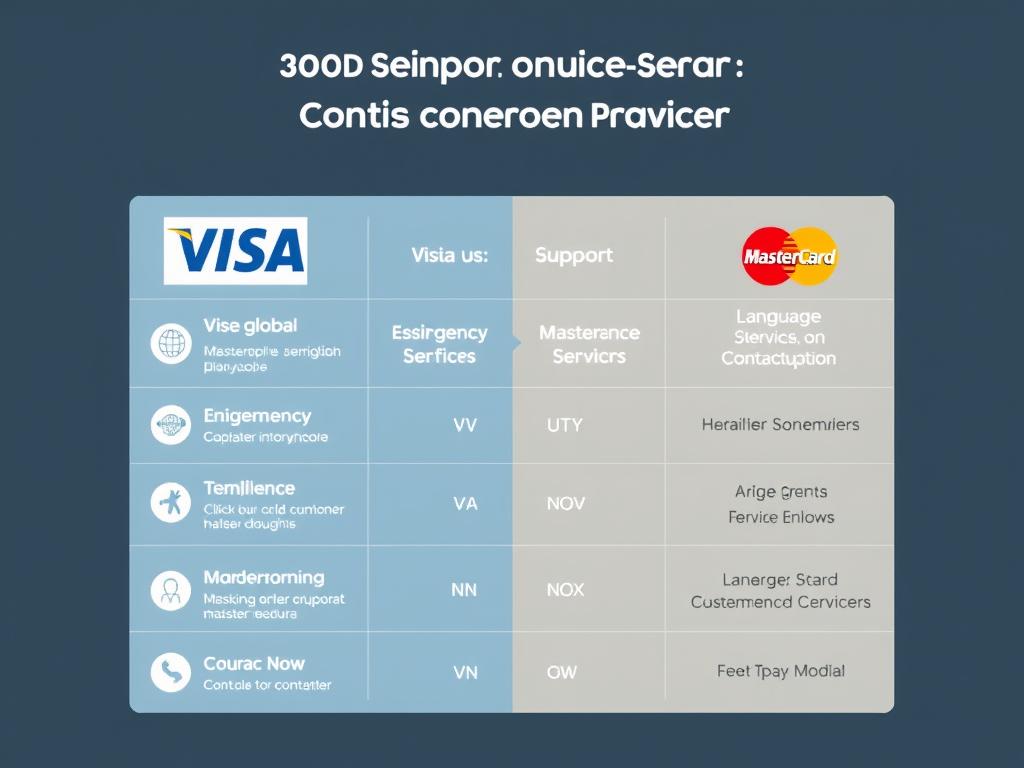
When traveling internationally, reliable customer support can be crucial, especially in emergency situations. Both Visa and Mastercard offer global assistance services, but with some notable differences in availability and features.
Global Assistance Centers
| Support Feature | Visa | Mastercard |
| Global Customer Assistance Centers | 1,700+ locations worldwide | 2,000+ locations worldwide |
| 24/7 Phone Support | Yes (toll-free in 200+ countries) | Yes (toll-free in 210+ countries) |
| Languages Supported | 16 languages | 20+ languages |
| Emergency Card Replacement | Within 24-72 hours globally | Within 24-72 hours globally |
| Emergency Cash Advance | Available at most locations | Available at most locations |
Emergency Services Comparison
Visa Emergency Services
- Global Customer Assistance Service (GCAS): 24/7 emergency assistance
- Emergency Card Replacement: Typically within 24-48 hours in major cities
- Emergency Cash Disbursement: Available at partner banks and Visa service centers
- Lost/Stolen Card Reporting: Centralized global system
- Medical and Legal Referrals: Available with premium cards
Mastercard Emergency Services
- Mastercard Global Service: 24/7 customer assistance worldwide
- Emergency Card Replacement: Typically within 24-48 hours in major cities
- Emergency Cash Advance: Available at partner locations globally
- Lost/Stolen Card Reporting: Centralized global system
- Mastercard Airport Concierge: Available with premium cards
“When my wallet was stolen in Rome, I called Mastercard’s global assistance line. They connected me with an Italian-speaking representative who helped file a police report and arranged for emergency cash at a local bank within hours. They had a replacement card delivered to my hotel the next day.”
Support Tip: Before traveling, save both your card issuer’s international customer service number AND the network’s global assistance number. While your issuer should be your first contact, network emergency services can provide crucial backup support if needed.
Traveler Decision Guide: Choosing the Right Card Network
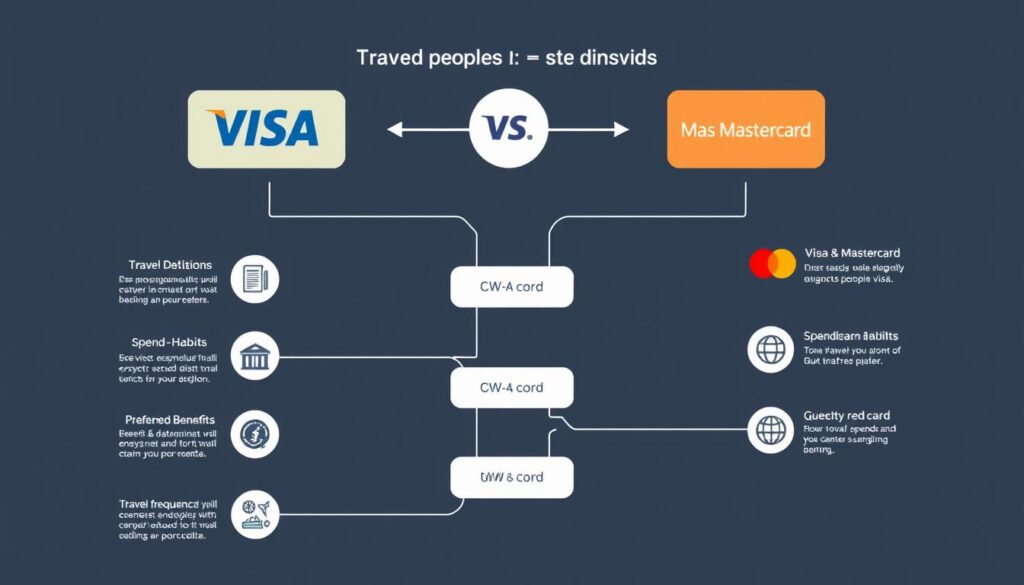
Choosing between Visa and Mastercard for international travel ultimately depends on your specific travel style, destinations, and priorities. Use this decision guide to determine which network might better suit your needs.
Choose Visa If:
- Your primary destinations include: Japan, Southeast Asia, Australia, Canada, or Latin America
- You prioritize: Slightly better acceptance at small merchants in rural areas of Asia and Oceania
- You value: Potentially stronger travel insurance benefits with premium cards
- You shop at: Costco in the United States (in-store purchases)
- You prefer: Slightly better exchange rates for Asian currencies
Choose Mastercard If:
- Your primary destinations include: Europe (especially Eastern Europe), Middle East, Africa, or Russia
- You prioritize: Maximum country coverage (210+ countries and territories)
- You value: Potentially better exchange rates for European currencies
- You appreciate: Slightly more extensive customer support language options
- You prefer: Exclusive experiences through Mastercard’s Priceless program
Travel Style Checklist
Budget Travelers
- Focus on cards with no foreign transaction fees regardless of network
- Consider Mastercard for travel in Europe where budget accommodations may favor it
- Look for cards with basic travel protections on either network
- Carry a backup payment method (different network or cash)
Luxury Travelers
- Consider premium cards (Visa Infinite or World Elite Mastercard)
- Prioritize comprehensive travel insurance and concierge services
- Look for hotel and airline partnerships that match your preferences
- Evaluate airport lounge access networks (Priority Pass vs. LoungeKey)
Frequent International Travelers
- Carry at least one card from each network for maximum flexibility
- Prioritize premium travel benefits and emergency services
- Consider region-specific cards for areas you visit frequently
- Look for cards with strong travel insurance and no foreign transaction fees
Occasional International Travelers
- Focus on cards with no foreign transaction fees
- Choose based on your specific destination’s preference
- Consider cards with basic travel protections
- Prioritize cards from issuers with strong mobile apps for travel notifications
Get the Best of Both Worlds
For maximum flexibility, consider carrying one card from each network. The Capital One Venture (Mastercard) and Chase Sapphire Preferred (Visa) make an excellent pairing for international travelers.
Conclusion: Making Your Final Decision
When comparing Visa vs Mastercard for international travel, the differences are relatively minor for most travelers. Both networks offer extensive global acceptance, similar foreign transaction fee structures, and comparable security features. Your specific destinations and travel style should guide your decision.
Choose Visa If
- You’re traveling primarily to Asia, Australia, or North America
- You shop at Costco in the US
- You prefer slightly stronger travel insurance benefits
- You value better acceptance at small merchants in rural Asia
Choose Mastercard If
- You’re traveling primarily to Europe, Africa, or the Middle East
- You want maximum country coverage (210+ countries)
- You prefer better exchange rates for European currencies
- You value more extensive language support options
Maximizing Both Networks: Smart Strategies
For the most seamless international travel experience, consider these strategies:
- Carry both networks: Having one card from each network provides maximum flexibility and backup options.
- Focus on the issuer: The card issuer often matters more than the network. Look for issuers offering no foreign transaction fees and strong travel benefits.
- Set travel notices: Always notify both card issuers before international travel to prevent security blocks.
- Download mobile apps: Both Visa and Mastercard offer apps with ATM locators and emergency contact information.
- Carry emergency contacts: Save global customer service numbers for both your card issuer and the card network.
“After years of international travel, I’ve found that having both a Visa and Mastercard is the optimal strategy. While the differences are subtle, having both networks has saved me from payment issues multiple times, especially in remote locations where one network might have limited acceptance.”
Ready for Your Next Adventure?
Compare the top travel credit cards from both networks to find the perfect match for your international travel needs.

Adam G
This post was created by Adam G, a seasoned financial writer with a passion for explaining currency exchange and market movements
